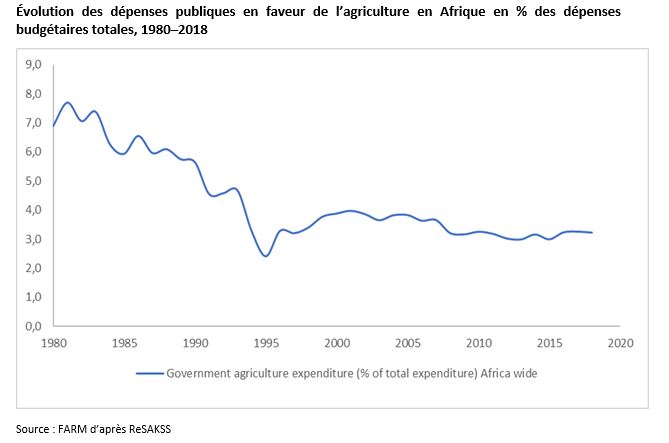In Africa, a narrow path for financing agricultural policies
The vast majority of sub-Saharan African countries are struggling to meet the commitment made in Malabo in 2014 to devote at least 10 billion of their budgets to agriculture. The economic crisis and rising debt levels due to Covid-19 are making it even more difficult to support the agricultural sector, which is at the heart of the enormous challenges facing the sub-region in terms of food security, combating deforestation, and adapting to climate change.
While the end of the pandemic and economic recovery are on the agenda in Europe and the United States, the situation is very different on the African continent. According to the latest forecasts from the International Monetary Fund[1], after a recession that caused gross domestic product (GDP) to plunge by 1.9% in 2020, sub-Saharan Africa is expected to experience the weakest growth in the world in 2021 (+3.4% in 2021). Given the population expansion, it is likely that GDP per capita will not return to its pre-pandemic level before 2022, or even 2025 depending on the country. And the outlook for economic activity remains highly uncertain, particularly due to the slow pace of vaccination.
Yet the sub-region is already struggling to finance its public policies. It is certainly convenient to highlight the increase in public debt, projected this year at 56 billion of GDP compared to 51 billion in 2019 and 34 billion over the period 2010-17. However, its weight remains much lower than that anticipated in high-income countries: 93 billion of GDP in the European Union, 133 billion in the United States. In reality, the problem is primarily due to the low tax revenues of African states and their difficulty in mobilizing domestic and foreign savings, due to the lack of investor confidence.[2].
“With limited resources, Reforms must prioritize those that strengthen resilience to future shocks and focus on sectors that offer the best returns for growth and employment., recommends the IMF. The priority is of course to ensure health security: to vaccinate 60% of the population, it would be necessary to increase health spending by 50%. Furthermore, no one disputes the need to strengthen social protection, the shortcomings of which have been highlighted by the health crisis. Neither education, which has been too neglected, nor infrastructure – energy, water, communication routes, etc. – which is cruelly insufficient. But one can question the importance really given by political decision-makers to the agricultural sector, and more broadly to the agri-food sectors, which nevertheless employ half of the workforce and determine nutritional security, severely tested by conflicts and climate change, and which has deteriorated with the worsening of poverty due to the pandemic.[3].
In fact, sub-Saharan Africa devotes just over 3% of its public spending to agriculture on average, three times less than planned in the Malabo Declaration. Worse, this rate has collapsed since the early 1980s. (chart)Only a handful of countries currently meet or exceed the 10 % target.

In this context of dwindling budgetary resources, the question arises of how to spend "better." This is at least what the FAO and the IMF recommend: that African governments scrutinize their agricultural policies to reduce the least effective aid, such as input subsidies, and increase support that has the best return on investment, in particular aid for research and extension, which are too often neglected.[4]This logic is understandable, but its social impact remains to be assessed, given the low investment capacity of small African farmers, which partly explains their poor productivity and high rural poverty rate. Not to mention that a reduction in production aid, granted in the form of input subsidies, risks further widening the gap between African farmers and their European and North American counterparts, but also Chinese and Indian ones, who are heavily supported by the State. This would not be of consequence if both were not operating in an increasingly globalized market.
[1]International Monetary Fund, Regional economic outlook. Sub-Saharan Africa: navigating a long pandemic, April 2021.
[2] Viviane Forson, “'A New Road' to Think Differently About Africa's Debt”, The Point, May 9, 2021.
[3]According to a recent study by IFPRI researchers, the Covid-19 pandemic led to a 5.8% drop in GDP in sub-Saharan Africa in 2020 and a 50 million increase in the number of people living in extreme poverty (less than $1.90 per day, in purchasing power parity). See D. Laborde et al., “Impacts of COVID-19 on global poverty, food security, and diets: Insights from global model scenario analysis”, Agricultural Economics / Early View, April 8, 2021.
[4]Opinion expressed during the webinar organized by FAO on May 7, "Public purse under pressure: current challenges and the future of government spending on food and agriculture in sub-Saharan Africa".
